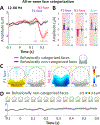All-or-none face categorization in the human brain
- PMID: 32119982
- PMCID: PMC7339021
- DOI: 10.1016/j.neuroimage.2020.116685
All-or-none face categorization in the human brain
Abstract
Visual categorization is integral for our interaction with the natural environment. In this process, similar selective responses are produced to a class of variable visual inputs. Whether categorization is supported by partial (graded) or absolute (all-or-none) neural responses in high-level human brain regions is largely unknown. We address this issue with a novel frequency-sweep paradigm probing the evolution of face categorization responses between the minimal and optimal stimulus presentation times. In a first experiment, natural images of variable non-face objects were progressively swept from 120 to 3 Hz (8.33-333 ms duration) in rapid serial visual presentation sequences. Widely variable face exemplars appeared every 1 s, enabling an implicit frequency-tagged face-categorization electroencephalographic (EEG) response at 1 Hz. Face-categorization activity emerged with stimulus durations as brief as 17 ms (17-83 ms across individual participants) but was significant with 33 ms durations at the group level. The face categorization response amplitude increased until 83 ms stimulus duration (12 Hz), implying graded categorization responses. In a second EEG experiment, faces appeared non-periodically throughout such sequences at fixed presentation rates, while participants explicitly categorized faces. A strong correlation between response amplitude and behavioral accuracy across frequency rates suggested that dilution from missed categorizations, rather than a decreased response to each face stimulus, accounted for the graded categorization responses as found in Experiment 1. This was supported by (1) the absence of neural responses to faces that participants failed to categorize explicitly in Experiment 2 and (2) equivalent amplitudes and spatio-temporal signatures of neural responses to behaviorally categorized faces across presentation rates. Overall, these observations provide original evidence that high-level visual categorization of faces, starting at about 100 ms following stimulus onset in the human brain, is variable across observers tested under tight temporal constraints, but occurs in an all-or-none fashion.
Copyright © 2020. Published by Elsevier Inc.
Figures









Similar articles
-
Rapid neural categorization of facelike objects predicts the perceptual awareness of a face (face pareidolia).Cognition. 2022 May;222:105016. doi: 10.1016/j.cognition.2022.105016. Epub 2022 Jan 11. Cognition. 2022. PMID: 35030358
-
Dissociable effects of inter-stimulus interval and presentation duration on rapid face categorization.Vision Res. 2018 Apr;145:11-20. doi: 10.1016/j.visres.2018.02.009. Epub 2018 Apr 12. Vision Res. 2018. PMID: 29581059 Free PMC article.
-
Varying Stimulus Duration Reveals Consistent Neural Activity and Behavior for Human Face Individuation.Neuroscience. 2021 Sep 15;472:138-156. doi: 10.1016/j.neuroscience.2021.07.025. Epub 2021 Jul 30. Neuroscience. 2021. PMID: 34333061
-
Uncovering the neural magnitude and spatio-temporal dynamics of natural image categorization in a fast visual stream.Neuropsychologia. 2016 Oct;91:9-28. doi: 10.1016/j.neuropsychologia.2016.07.028. Epub 2016 Jul 25. Neuropsychologia. 2016. PMID: 27461075
-
Fast periodic presentation of natural images reveals a robust face-selective electrophysiological response in the human brain.J Vis. 2015 Jan 16;15(1):15.1.18. doi: 10.1167/15.1.18. J Vis. 2015. PMID: 25597037
Cited by
-
Auditory category learning is robust across training regimes.Cognition. 2023 Aug;237:105467. doi: 10.1016/j.cognition.2023.105467. Epub 2023 May 4. Cognition. 2023. PMID: 37148640 Free PMC article.
-
Face-selective responses in combined EEG/MEG recordings with fast periodic visual stimulation (FPVS).Neuroimage. 2021 Nov 15;242:118460. doi: 10.1016/j.neuroimage.2021.118460. Epub 2021 Aug 5. Neuroimage. 2021. PMID: 34363957 Free PMC article.
-
Olfactory-to-visual facilitation in the infant brain declines gradually from 4 to 12 months.Child Dev. 2024 Nov-Dec;95(6):1967-1981. doi: 10.1111/cdev.14124. Epub 2024 Jul 18. Child Dev. 2024. PMID: 39022837 Free PMC article.
-
Cross-Validating the Electrophysiological Markers of Early Face Categorization.eNeuro. 2025 Jan 28;12(1):ENEURO.0317-24.2024. doi: 10.1523/ENEURO.0317-24.2024. Print 2025 Jan. eNeuro. 2025. PMID: 39809534 Free PMC article.
-
Visual Stimulation Under 4 Hz, Not at 10 Hz, Generates the Highest-Amplitude Frequency-Tagged Responses of the Human Brain: Understanding the Effect of Stimulation Frequency.eNeuro. 2025 Jun 17;12(6):ENEURO.0426-24.2025. doi: 10.1523/ENEURO.0426-24.2025. Print 2025 Jun. eNeuro. 2025. PMID: 40527617 Free PMC article.
References
-
- Adrian ED, Matthews BHC (1934). The Berger rhythm: Potential changes from the occipital lobes in man. Brain, 4 (57), 355–385. - PubMed
-
- Allison T, Ginter H, McCarthy G, Nobre AC, Puce A, Luby M & Spencer DD (1994). Face recognition in human extrastriate cortex. Journal of Neurophysiology, 71(2), 821–825. - PubMed
-
- Bacon-Macé N, Macé MJ, Fabre-Thorpe M & Thorpe SJ (2005). The time course of visual processing: backward masking and natural scene categorisation. Vision Research, 45(11), 1459–1469. - PubMed
-
- Bar M, Tootell RBH, Schacter DL, Greve DN, Fischl B, Mendola JD, Rosen BR & Dale AM (2001). Cortical mechanisms specific to explicit visual object recognition. Neuron, 29(2), 529–535. - PubMed
Publication types
MeSH terms
Grants and funding
LinkOut - more resources
Full Text Sources

